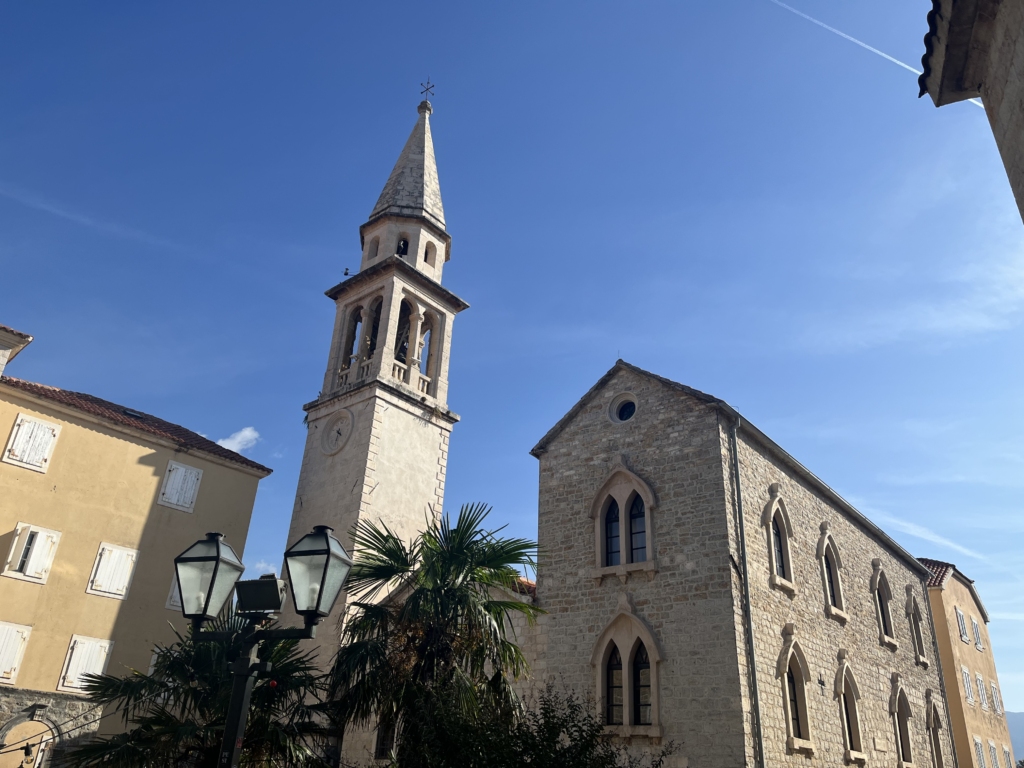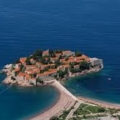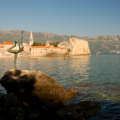Although Budva is one of the most popular tourist destinations in Montenegro, its versatile offer includes many free things and fun places to enjoy and explore. Dubbed the Miami of Montenegro shore has attracted visitors due to its merry beaches, the historical allure of the old town, and incredible nightlife that rivals some of the world’s most famous destinations.
Although, like any touristy town, Budva has some attractions for which you need to break the bank, such as a visit to Sveti Stefan or entrance to some museums and historical attractions, some things are still free of charge.
If however you are on a tight budget, we are here to help you. Keep reading and discover the top 8 free places to visit in Budva that must be on your itinerary list:
Budva City Walls
Budva’s city walls are one of the most striking features and give it a unique charm. This walkable attraction surrounds the core of the Old Town and represents a distinct historical defence mechanism. The city walls date back to the Middle Ages when the Venetians governed these regions. The city walls urban core sustained some damage from two major earthquakes in 1667 and 1979, some of which are evident even today.

Today, they are recognised as a truly remarkable spot that should not be missed during a visit to Budva. The best thing about it is that a big part of the wall is free so you can access throughout day and night. Portion of the wall is connected to the citadel, so you must pay an admission fee but only during the hottest part of the summer; otherwise, it is either free or locked.
The most visited part of the city walls is near the small square, where you can find the church and the so-called “summer theatre scene”. During July and August, Budva Art Fest is held here and it hosts different theatre plays. Many people can gather for the rest of the year to watch local street musicians perform.
Budva’s city walls is also some of the best places in the city to enjoy the unique fire-red summer sunsets. Here, you can fully grasp the mesmerising nature of the Adriatic Sea and truly feel the peacefulness of the Mediterranean way of life.
Old Town Budva
Old Town is one of the most striking places that dominate Budva’s landscape. This unique place is also on the list of the best free things to do in Budva. Here, you will experience the hub of the city’s activities and vivacious nightlife during summer.
The Old Town is well known for its distinctive architecture and urban features that date back to the ancient era. Those sources claim that Budva, which is over 2,500 years old, is one of the oldest cities in the Adriatic. Its Old Town is presumed to date back to the same period. It has various entrances, all leading to the narrow streets that hid some of the best pubs and restaurants in town.
Although it can remind you of the labyrinth, the streets of Old Town have unique features and are filled with other numerous attractions. The oldest building in Old Town is Church of Sveta Marija, dating from 840 A.D., and the Church of Sveti Trojica was constructed in 1804. This incredible place is also home to several picturesque squares with historical buildings, as well as countless religious objects that date back to the 16th century and further.
Most of these attractions are also free and easily accessed, making the Old Town even more attractive.
Statue Ballerina
The Statue “Ballerina”, or Budva’s Dancing Girl, is a symbol of the city and yet another free thing to visit in Budva. This incredible sculpture is located between the Old Town and Mogren Beach, on the rocks near the sea. The sculpture was inspired by Olga Kalivoda, an athlete who was eternalised by by the Serbian vajar Gradimir Aleksića. The statue has several copies, but the one in Budva is the most famous.

The Budva’s “Balerina,” is attributed to a moving story from the local folklore. It centres on a touching story about a young girl and a sailor who are sincerely in love but separated by financial difficulties. The girl promised herself that she would wait for her love to return, going to the seaside cliff and longing to see his ship in the distance. Sadly, the sailor never came back, and the girl continued waiting until her death. She was found on the very beach where “Balerina” now stands, representing the eternal spirit of love and longing.
Today, this statue is a famous item in Budva, attracting tourists to enjoy the peaceful scenary. It is a mersmerising spot where the Adriatic sea is in front of you in all of its glory.
Podmaine Monastery
The Crnojević aristocratic family built the church in 1747. It is located near a smaller, older chapel dedicated to the Presentation of the Mother of God. This holy object was constructed in the fifteenth century. Since then, it has been repaired multiple times and serves as a protected haven for believers along the Adriatic coast.

Besides its masterful exterior architecture, the Maine Monastery is known for its interior. Besides its incredible altar, the walls of the monastery are equally worthy of your attention. Inside the Church of St. Petka you can find paintings that date back to 1747. They are done by Corfu-born Nicholaos Aspioti and Risan-native Rafail Dimitrijević.
Another notable elements in the monastery’s interior are frescos that include a modern-day rendition of the Last Judgement. It depicts the heads of the uncanonical Montenegrin Orthodox Church and former Yugoslav leader Tito as damned and handed over to devils who herd them down into hell.
Mogren Beach
Mogren is one of Budva’s best-known beaches and one of Montenegro’s well-liked secluded spots. Hidden behind the hills of Budva, right next to the shore, Mogren has been a sanctuary for locals and some informed tourists.

The Mogren Beach is divided in two sections – Mogren I and Mogren II. They are connected by a tiny wooden bridge. Both locations have gorgeous views of St. Nicholas Island and Old Budva. To reach them, you take a short but picturesque stroll next to the Old Town, following a narrow path by the sea. You pass by the famous Balerina statue, and Mogren Beach is right before you.
Despite its prominence, Mogren retains a sense of privacy amidst the commotion. The cliffs behind are covered with lush Mediterranean vegetation, while oak and pine woods rise on the slopes beyond. The beach has golden sand and gently slopes into the Adriatic Sea.
The entrance to the beach is not paid, therefore, Mogren is rightfully on the list of the top 8 free places to see in Budva.
Citadel
Budva’s Citadel is a striking part of Old Town. It is a uniquely preserved fortification from the Middle Ages built on a hill and overlooking the Adriatic Sea. Its inhabitants have included Illyrians, Romans, Byzantines, Venetians, and Ottomans, among others. The Budva Citadel is one of Montenegro’s most significant historical and cultural sites. It has fought in several wars and conflicts and functioned as a strategic stronghold for ages.
The Citadel is a part of the Old Town complex and occasionally people struggle to find it. In order to reach this historical marvel you need to enter the Old Town through main gates known as the Riva or Sea Gate. From there, walk towards the ocean until you reach the end of the main street. Look for stairs on your left leading up to the citadel. Ascend these stairs to reach the fortress at the hilltop, passing charming stores and historic buildings. At the summit, enjoy stunning views of the Adriatic Sea and coastline.
The entrance to the citadel is free, so you can fully enjoy this iconic sight in Budva. A small tip from the locals, visit Citadel during sunset to experience all of its charm.
Church of the Holy Trinity
A church dedicated to the Holy Trinity is located near the Old Town walls and the Citadel on the west side of the short stretch of land.
The Church of Holy Trinity was completed in 1804, having been requested by the orthodox community of Budva with backing from the Bishop of Montenegro. This is a significant landmark as it represents the celebration of the fall of the Venetian Republic in 1797.
The church is architectural marvel, featuring a dome and a bell loft with three bells. Done in traditional Mediterranean style, above the western door you will notice a rosette adorns the facade. Greek iconographers from the 19th century created the church’s iconostasis, which is extremely valuable artistically.

It is one of the best examples of ecclesiastical architecture, with some beautiful pieces that will captivate you. These include a 14th-century sanctuary knocker and 15th-century misericord chairs decorated with religious, secular, and legendary motifs. Stefan Mitrov Ljubiša, a Budva-based writer and politician, is buried in front of the church.
With this historical significance and cherished treasure, this incredible spot should be on your itinerary list. The entrance to Holy Trinity is free, but you are invited to donate for the preservation of the church.
Krapina Village
Krapina Village is the ultimate hidden paradise located 5 km away from the bustling centre of Budva. Taking a winding road along serpentines through beautiful areas of untouched nature, you will reach the village, which offers a variety of facilities to enjoy.

This family-owned village introduced the concept of “etno” into the Adriatic lifestyle as it includes local cuisine, organic products, enjoyment by the waterfall, eco-swimming, and going down the zip line.
Krapina boasts a variety of other attractions due to its position, including a natural swimming pool where you can take in all of the area’s splendor. In addition, you may experience amazing wildlife, walk along a hand-made wood path, breathe fresh air, and appreciate the beauty of a well-hidden tiny canyon. You can also go from here to the waterfall that emerges from the rock. It’s a wonderful small nook that adds to the appeal of Krapina village.
Besides natural delights, Krapina is also home to many farm animals that have been adopted. In addition to cats, dogs, and bunnies, you can find donkeys, geese, hens, and pigs. Next to the restaurant, you can also admire a small poolfish.



 Montenegrin Essentials
Montenegrin Essentials  – Planning a trip to Montenegro?
– Planning a trip to Montenegro?  These travel essentials will help you plan your journey
These travel essentials will help you plan your journey  to Montenegro with
to Montenegro with  through
through 





